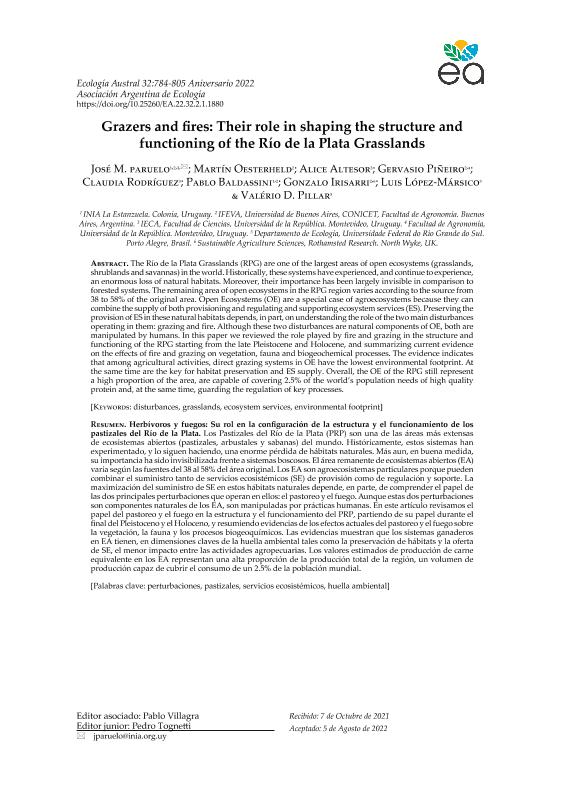Artículo
Los Pastizales del Río de la Plata (PRP) son una de las áreas más extensas de ecosistemas abiertos (pastizales, arbustales y sabanas) del mundo. Históricamente, estos sistemas han experimentado, y lo siguen haciendo, una enorme pérdida de hábitats naturales. Más aun, en buena medida, su importancia ha sido invisibilizada frente a sistemas boscosos. El área remanente de ecosistemas abiertos (EA) varía según las fuentes del 38 al 58% del área original. Los EA son agroecosistemas particulares porque pueden combinar el suministro tanto de servicios ecosistémicos (SE) de provisión como de regulación y soporte. La maximización del suministro de SE en estos hábitats naturales depende, en parte, de comprender el papel de las dos principales perturbaciones que operan en ellos: el pastoreo y el fuego. Aunque estas dos perturbaciones son componentes naturales de los EA, son manipuladas por prácticas humanas. En este artículo revisamos el papel del pastoreo y el fuego en la estructura y el funcionamiento del PRP, partiendo de su papel durante el final del Pleistoceno y el Holoceno, y resumiendo evidencias de los efectos actuales del pastoreo y el fuego sobre la vegetación, la fauna y los procesos biogeoquímicos. Las evidencias muestran que los sistemas ganaderos en EA tienen, en dimensiones claves de la huella ambiental tales como la preservación de hábitats y la oferta de SE, el menor impacto entre las actividades agropecuarias. Los valores estimados de producción de carne equivalente en los EA representan una alta proporción de la producción total de la región, un volumen de producción capaz de cubrir el consumo de un 2.5% de la población mundial. The Río de la Plata Grasslands (RPG) are one of the largest areas of open ecosystems (grasslands, shrublands and savannas) in the world. Historically, these systems have experienced, and continue to experience, an enormous loss of natural habitats. Moreover, their importance has been largely invisible in comparison to forested systems. The remaining area of open ecosystems in the RPG region varies according to the source from 38 to 58% of the original area. Open Ecosystems (OE) are a special case of agroecosystems because they can combine the supply of both provisioning and regulating and supporting ecosystem services (ES). Preserving the provision of ES in these natural habitats depends, in part, on understanding the role of the two main disturbances operating in them: grazing and fire. Although these two disturbances are natural components of OE, both are manipulated by humans. In this paper we reviewed the role played by fire and grazing in the structure and functioning of the RPG starting from the late Pleistocene and Holocene, and summarizing current evidence on the effects of fire and grazing on vegetation, fauna and biogeochemical processes. The evidence indicates that among agricultural activities, direct grazing systems in OE have the lowest environmental footprint. At the same time are the key for habitat preservation and ES supply. Overall, the OE of the RPG still represent a high proportion of the area, are capable of covering 2.5% of the world’s population needs of high quality protein and, at the same time, guarding the regulation of key processes.
Grazers and fires: Their role in shaping the structure and functioning of the Río de la Plata Grasslands
Paruelo, José ; Oesterheld, Martin
; Oesterheld, Martin ; Altesor, Alice; Piñeiro, Gervasio
; Altesor, Alice; Piñeiro, Gervasio ; Rodríguez, Claudia; Baldassini, Pablo
; Rodríguez, Claudia; Baldassini, Pablo ; Irisarri, Jorge Gonzalo Nicolás
; Irisarri, Jorge Gonzalo Nicolás ; López Mársico, Luis; Pillar, Valério D.
; López Mársico, Luis; Pillar, Valério D.
 ; Oesterheld, Martin
; Oesterheld, Martin ; Altesor, Alice; Piñeiro, Gervasio
; Altesor, Alice; Piñeiro, Gervasio ; Rodríguez, Claudia; Baldassini, Pablo
; Rodríguez, Claudia; Baldassini, Pablo ; Irisarri, Jorge Gonzalo Nicolás
; Irisarri, Jorge Gonzalo Nicolás ; López Mársico, Luis; Pillar, Valério D.
; López Mársico, Luis; Pillar, Valério D.
Fecha de publicación:
09/2022
Editorial:
Asociación Argentina de Ecología
Revista:
Ecología Austral
ISSN:
0327-5477
Idioma:
Español
Tipo de recurso:
Artículo publicado
Clasificación temática:
Resumen
Palabras clave:
DISTURBANCES
,
GRASSLANDS
,
ECOSYSTEM SERVICES
,
ENVIRONMENTAL FOOTPRINT
Archivos asociados
Licencia
Identificadores
Colecciones
Articulos(IFEVA)
Articulos de INST.D/INV.FISIOLOGICAS Y ECO.VINCULADAS A L/AGRIC
Articulos de INST.D/INV.FISIOLOGICAS Y ECO.VINCULADAS A L/AGRIC
Citación
Paruelo, José; Oesterheld, Martin; Altesor, Alice; Piñeiro, Gervasio; Rodríguez, Claudia; et al.; Grazers and fires: Their role in shaping the structure and functioning of the Río de la Plata Grasslands; Asociación Argentina de Ecología; Ecología Austral; 32; 2bis; 9-2022; 784-805
Compartir
Altmétricas



